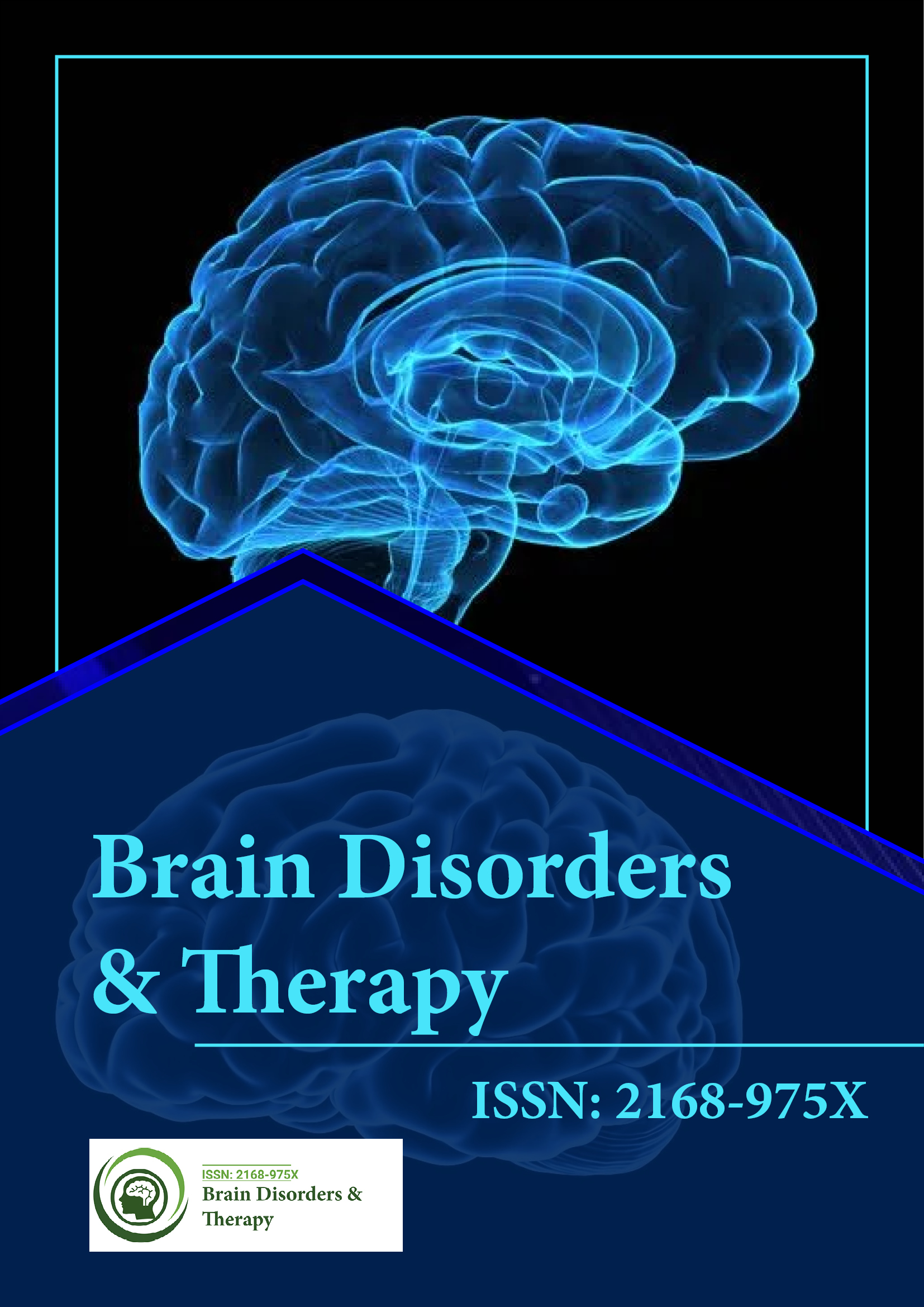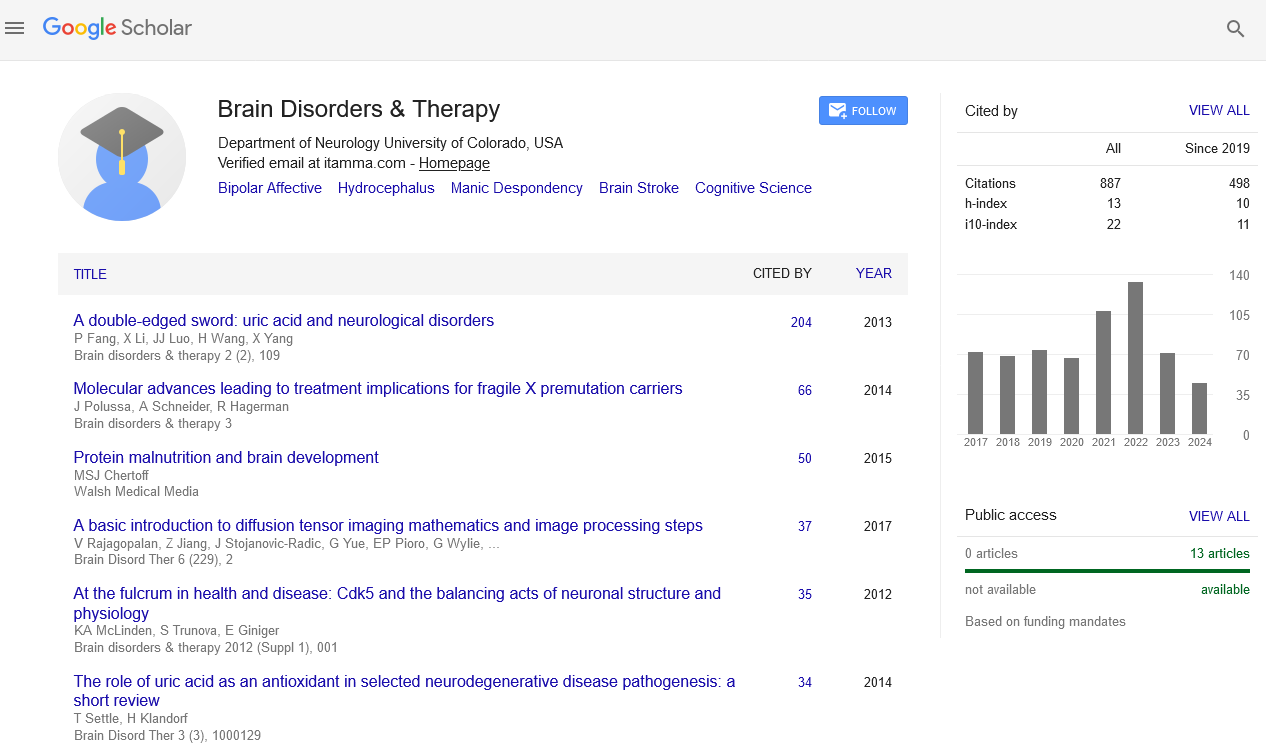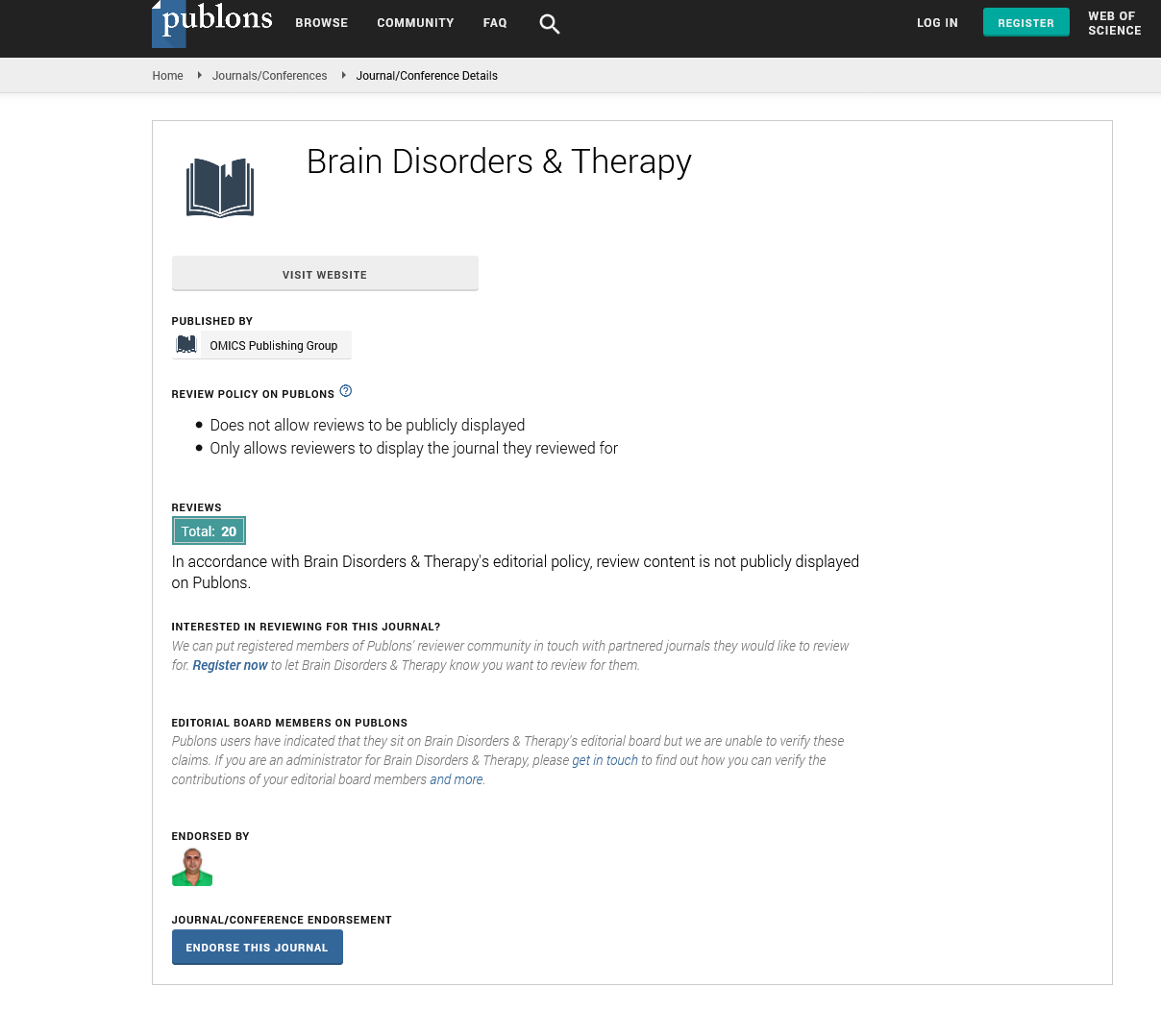Indexed In
- Open J Gate
- Genamics JournalSeek
- JournalTOCs
- RefSeek
- Hamdard University
- EBSCO A-Z
- OCLC- WorldCat
- Publons
- Geneva Foundation for Medical Education and Research
Useful Links
Share This Page
Journal Flyer

Open Access Journals
- Agri and Aquaculture
- Biochemistry
- Bioinformatics & Systems Biology
- Business & Management
- Chemistry
- Clinical Sciences
- Engineering
- Food & Nutrition
- General Science
- Genetics & Molecular Biology
- Immunology & Microbiology
- Medical Sciences
- Neuroscience & Psychology
- Nursing & Health Care
- Pharmaceutical Sciences
Opinion Article - (2024) Volume 13, Issue 3
The Critical Role of Glycemic Control in Traumatic Brain Injury Outcomes
Tariq Villafane*Received: 26-Aug-2024, Manuscript No. BDT-24-27112; Editor assigned: 29-Aug-2024, Pre QC No. BDT-24-27112(PQ); Reviewed: 12-Sep-2024, QC No. BDT-24-27112; Revised: 19-Sep-2024, Manuscript No. BDT-24-27112(R); Published: 26-Sep-2024, DOI: 10.35248/2168-975X.24.13.273
Description
Traumatic Brain Injury (TBI) is a major public health concern, resulting in significant morbidity and mortality worldwide. Among the many factors influencing outcomes in TBI patients, glycemic control has emerged as a critical component of effective management. Dysglycemia, characterized by hyperglycemia or hypoglycemia, can lead to poor recovery and increased complications, making the regulation of blood glucose levels a focal point of research in TBI. This article provides an overview of a systematic review and meta-analysis assessing the impact of glycemic control on outcomes in TBI.
The association between glycemic control and TBI outcomes has garnered considerable interest in recent years, as hyperglycemia has been consistently linked to worse neurological outcomes. Studies suggest that elevated blood glucose levels can exacerbate secondary injury mechanisms, such as inflammation, oxidative stress and apoptosis, leading to increased neuronal damage. Conversely, maintaining optimal glycemic levels may mitigate these adverse effects, potentially improving recovery and long-term prognosis.
To investigate the relationship between glycemic control and outcomes in TBI, researchers conducted a systematic review and meta-analysis. The review aimed to synthesize data from various studies that evaluated the effects of glycemic management on clinical outcomes in TBI patients. The analysis focused on several key outcome measures, including mortality rates, neurological recovery and length of hospital stay.
Inclusion criteria encompassed randomized controlled trials, cohort studies and case-control studies that assessed glycemic control in adults with TBI. The primary outcomes were mortality rates, Glasgow Coma Scale (GCS) scores and functional recovery, as measured by validated assessment tools.
The analysis revealed several key findings. Firstly, the pooled data indicated a significant correlation between hyperglycemia and increased mortality in TBI patients. Elevated blood glucose levels at admission were associated with higher mortality rates, underscoring the importance of prompt glycemic management in the acute setting. Moreover, patients who maintained tighter glycemic control, particularly those with blood glucose levels within the normal range, demonstrated improved neurological outcomes and recovery scores.
In addition to mortality and recovery metrics, the review highlighted the impact of glycemic control on the length of hospital stay. Patients who experienced hyperglycemia during their hospitalization often faced prolonged stays, attributed to complications arising from poor glycemic control, such as infections and delayed neurological recovery. This finding emphasizes the potential economic burden associated with dysglycemia in TBI patients and the need for effective glycemic management protocols to enhance clinical efficiency.
A noteworthy aspect of the analysis was the exploration of various glycemic control strategies. Some studies investigated the efficacy of insulin therapy in managing hyperglycemia in TBI patients. Insulin administration has been shown to improve glycemic control and is often employed in critical care settings. The review found that aggressive insulin therapy in patients with TBI led to better glycemic control and, in some cases, improved clinical outcomes, although the optimal approach remains a topic of ongoing research.
Another critical consideration in the review was the timing of glycemic control interventions. Early initiation of glycemic management was associated with better outcomes, suggesting that prompt treatment of hyperglycemia in the acute phase of TBI could be crucial in mitigating secondary brain injury. Furthermore, maintaining glucose levels within a target range (generally between 80 and 140 mg/dL) emerged as a consensus recommendation in the literature.
Despite the compelling evidence supporting glycemic control in TBI, the review also acknowledged some limitations in the existing studies. Variability in study designs, patient populations and glycemic management protocols could influence the generalizability of the findings. Additionally, the lack of largescale, multicenter trials limits the ability to draw definitive conclusions about the best practices for glycemic management in TBI.
Conclusion
The systematic review and meta-analysis provide strong evidence for the importance of glycemic control in traumatic brain injury. Maintaining optimal blood glucose levels is associated with improved clinical outcomes, including reduced mortality, enhanced neurological recovery and shorter hospital stays. The findings underscore the necessity of implementing standardized glycemic management protocols in TBI care, emphasizing early intervention and targeted strategies to mitigate dysglycemia. As research in this area continues to evolve, future studies should focus on refining glycemic control practices and exploring individualized treatment approaches to optimize outcomes for patients with traumatic brain injury. By prioritizing glycemic management, healthcare providers can contribute to better recovery trajectories and enhanced quality of life for individuals affected by TBI.
Citation: Villafane T (2024). The Critical Role of Glycemic Control in Traumatic Brain Injury Outcomes. Brain Disord Ther. 13:273.
Copyright: © 2024 Villafane T. This is an open-access article distributed under the terms of the Creative Commons Attribution License, which permits unrestricted use, distribution, and reproduction in any medium, provided the original author and source are credited.


